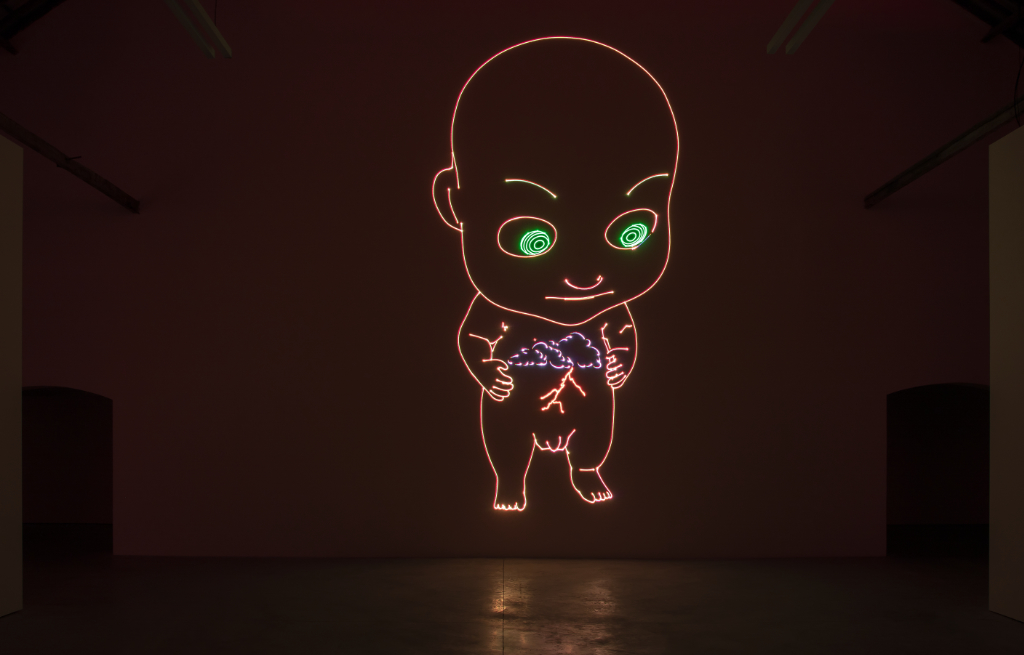Text by Alessandra Coretti
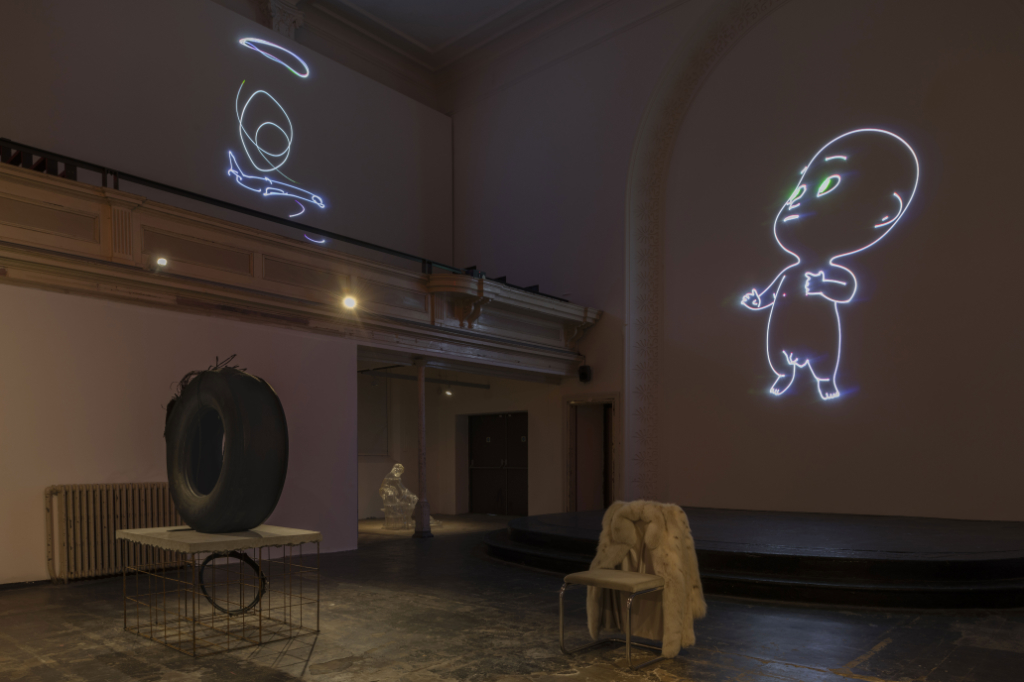
All Crescendo, No Reward, the current exhibition at the Zabludowicz Collection, interacts with the polymorphic nature of the place, like a vibration, a constantly changing temperature. It flows between the different areas of the gallery and wraps visitors in a sensory continuum. The gallery, explains Paul Luckraft, curator of the project, has an eclectic and shape-shifting vocation. Born as a Methodist chapel before becoming a drama school for many decades, the Camden Town venue in London is a key platform for emerging artists playing with contemporary media and for a curious and dynamic audience interested in experiencing art through hands-on approaches.
All Crescendo, No Reward includes works by artists who express contemporary tensions and urgencies through very different textures. It was conceived as a journey through different artistic expressions, from painting to sculpture, video to installation, and sound to performance, to explore themes such as identity, desire, subjectivity and objectivity, life and death.
All of the works in the exhibition are in the Zabludowicz Collection. For about a year, the idea for the show developed through several phases, with the recently acquired installation by Matt Copson being the starting point, and then expanding this to think about a conversation between a range of artists, perhaps who had not been shown together before. It is also a chance to share and celebrate powerful works with the public that we had yet to have the pleasure of presenting. Explains Paul Luckraft.
The relational dimension, diversity and identity construction are the cornerstones of the exhibition. A continuous exchange between these conceptual nodes guides the exhibition’s development. They make up its underlying plot and rhythm. The identity construction that the concept refers to isn’t a linear process nor isolated in vitro. Instead, it’s seen as a cartographic motion [1] that opens up to infinite possibilities, paths and derailments. Above all, it’s also fluid matter, not fixed. This sense of mutating subjectivity, an image borrowed from the aesthetics of Deleuze and Guattari [2], repositions art and the production of meaning connected to it solely within a complex relational system.
This universe defines itself by plurality and contingent situations. In this stratification of meanings, this continuous change of perspective, this encounter/clash between different sign systems, we identify the creative tension, the deeper meaning of All Crescendo, No Reward.
Luckraft shares with CLOT that the atmosphere the show creates is one of ever-shifting states, of things unfixed and pushing their limits. I was thinking about time as a loop rather than a linear movement. Maybe there is a sense that the ‘characters’ in the show – Matt Copson’s baby drawn by lasers, Oliver Laric’s 3D printed translucent Sleeping Boy, Frances Stark’s collaborator Bobby Jesus or even Frances Stark herself in the role as ‘the artist’ – are trapped in a kind of loop. The show reflects on the fact that we form our identities in relation to other people and other objects in the world, a set of archetypes that are labelled through language. Everything is contingent and relational.

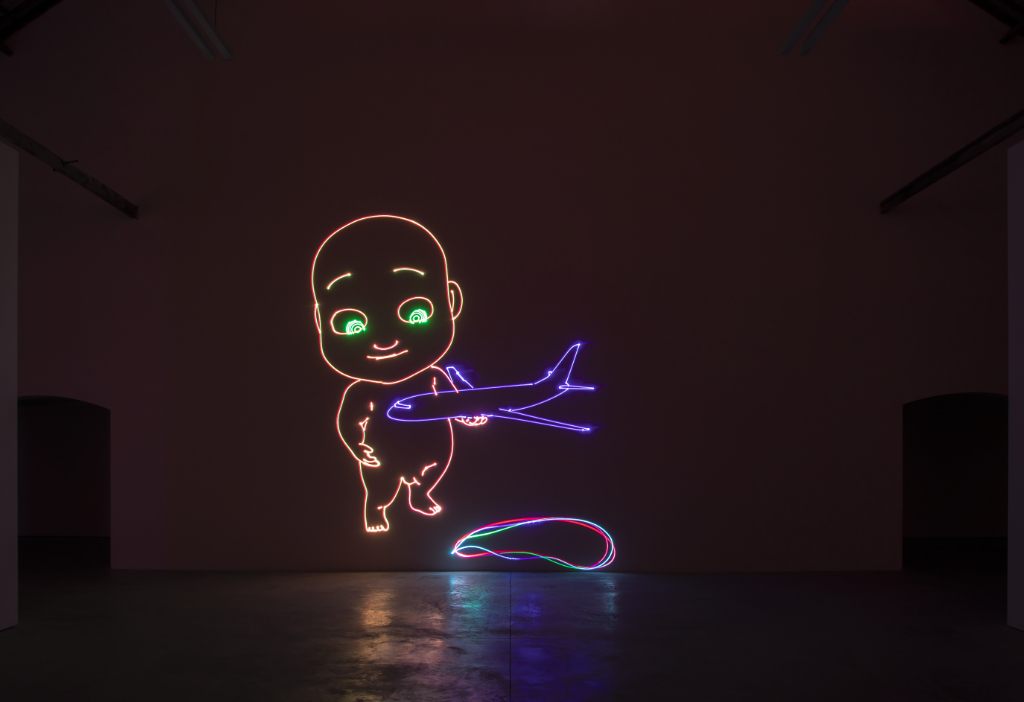
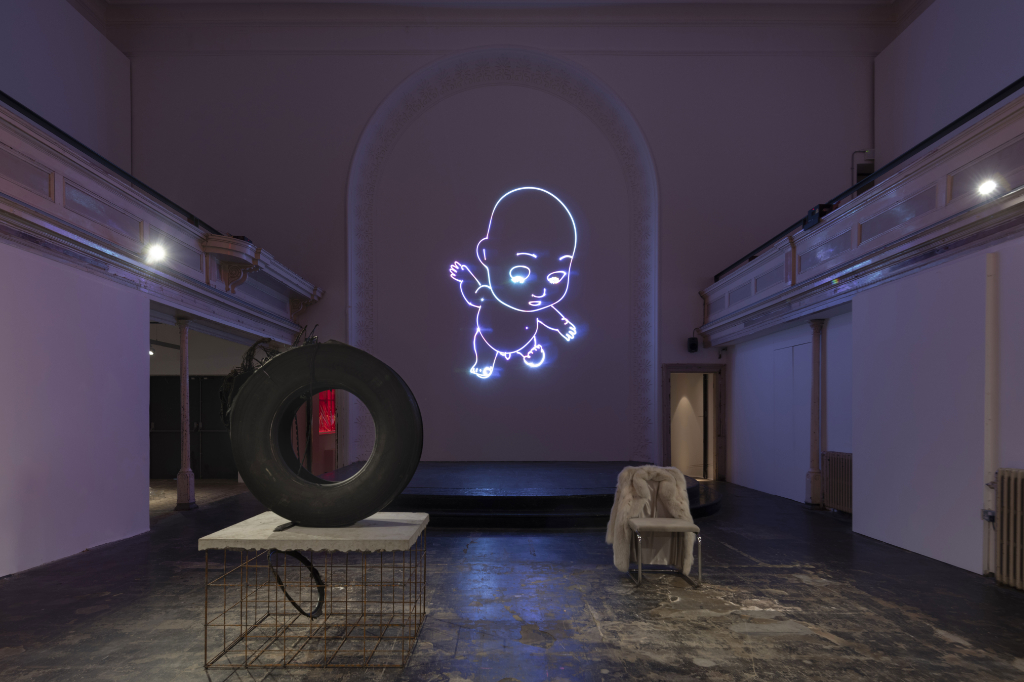
Matt Copson’s Age of Coming (2021) is one of the most emblematic installations of the exhibition. The work tells the story of a child (a cherub from the Renaissance imagination) who goes through various stages of growth, voraciously approaching the world. In this work, the artist analyses the crucial pieces of identity construction: play, risk, and ego satisfaction. Copson was drawn to laser technology because he liked the uncomfortable intensity of the light and because, in programming the machines to draw fluid lines, he was pushing the technology to the limit of its capabilities.
Olivier Laric and Frances Stark address the same topics through technological devices, starting from different points of view. Much more complex and engaging technological mechanisms have been used in both cases. Oliver Laric is presenting sculptures and an animated video in the show. Blurring the lines between ideas of original and copy is central to Laric’s research. For his sculptures, he uses new technologies of 3D scanning to map objects from museums, creating a database of digital model files, which he makes freely available on his website threedscans.com.
Luckraft tells us that Laric’s animation Untitled (2014–15) takes its imagery from the history of animation. Laric spent two years finding moments of metamorphosis and the involuntary transformation of characters. He painstakingly redrew these frames, such as iconic scenes from early Disney, such as Pinocchio, combined with lesser-known anime and fan art—the animation shifts from flowing lines to more static 4 K-rendered CGI objects and devices. The resulting film is a rolling flow between different states: old to young, human to animal, hard object to soft flesh.
Frances Stark’s installation is much more personal and autobiographical than, Luckraft continues, but it also used various forms of technology to reflect on how we form our identity through and with the lives and voices of others. Bobby Jesus’s Alma Mater b/w Reading the Book of David and/or Paying Attention Is Free (2013) is a text-based video set to a booming hip-hop soundtrack sampled from Stark’s musical hero DJ Quik. The video is projected over a large wall graphic, a visual collage or photo portrait, images from art history books, Christian iconography and educational documents.
The mural is a ‘stage’ for the projected video above it. Lines of text, written by Stark and animated in her font designs, pulse and scroll across the wall to the rhythm of a hip-hop soundtrack. The work is angry and confrontational about social injustice and the over-commercialisation of culture. Still, at the same time, it’s a witty and emotional tribute to friendship and fandom.
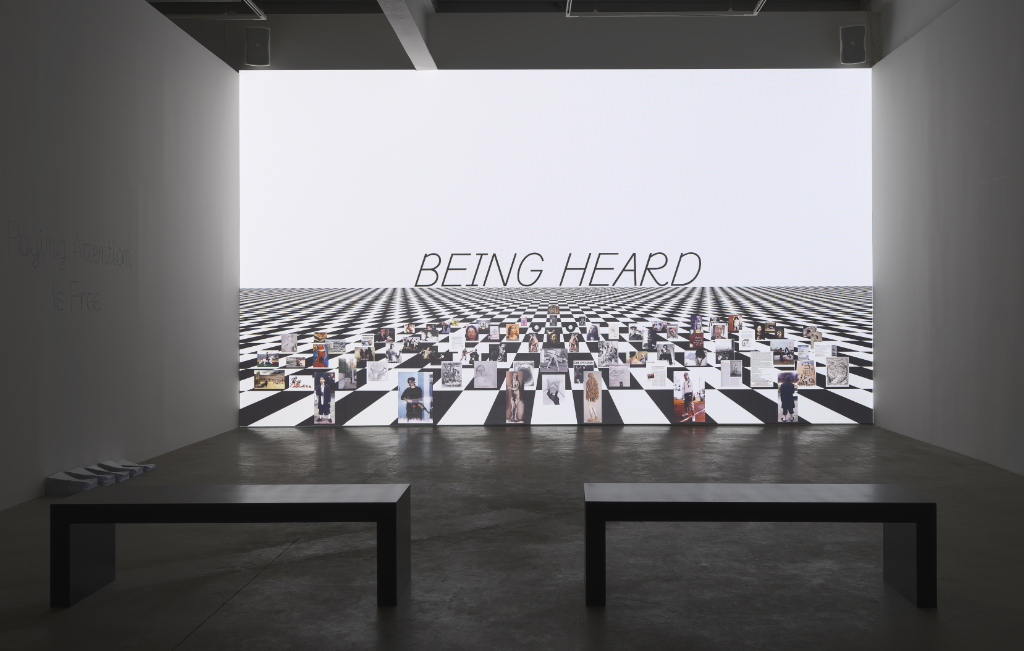

Lynda Benglis, with the work Bird’s Nest #2 (2016), intercepts a much more radical line of research. Benglis brings to the project her sculpture and all the power of her background: her pioneering charm and the vision of a femininity not defined by the male gaze. For All Crescendo No Reward, she exhibits a work that celebrates desire without defining it, without giving it boundaries of form. The fluidity of her sculpture’s form also coincides with the opening of the meaning of the work, which opens up the possibilities of its audience.
Another significant figure in the exhibition is Mike Nelson. Throughout his career, Nelson has often expressed visceral poetics in the places where he has exhibited his works. The work shown at the Zabludowicz Collection is A7 (Route du Soleil) (2015) […], a sculptural work composed of a damaged truck tire placed on a sort of plinth of concrete and metal bars. It is part of a series of works where Nelson reuses objects found along highways. The titles refer to the roads where they were found, in this case, the A7 linking Lyon and Marseille, known as the Autoroute du Soleil.
This work also results from a network of resonances and possible paths. As with Benglis, for Nelson, it is important to leave the responsibility of vision to the viewer. Inputs and suggestions are provided throughout the works, but the viewers find themselves in an open circuit that they can explore and reactivate with different meanings. It is up to them to lose and find themselves.
The project was designed as a journey through the spaces for viewers, one in which the atmosphere would shift. Music and sound are key, as they flow between the rooms, so you get some interesting cross-pollination. […] I hope that we’ve given each artwork in the show a certain presence, and been sensitive to the backstories of the objects and considered how they can be represented in a new configuration that has a playful quality and is fun while also reflecting on the complexity and tension of being an entity in a world of other unknowable entities. Luckraft concludes.

